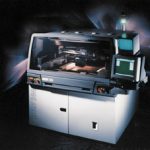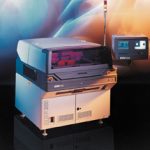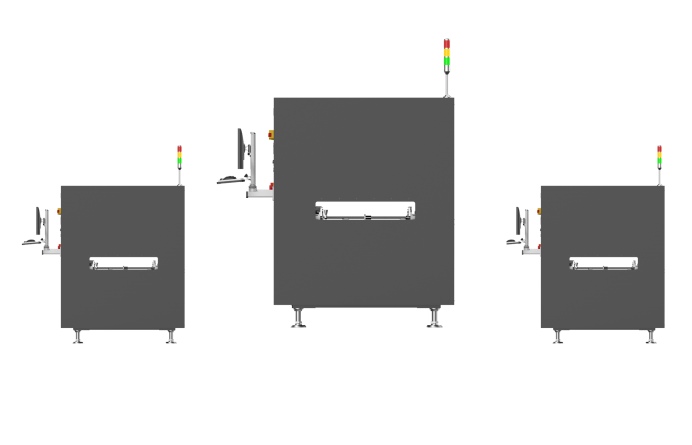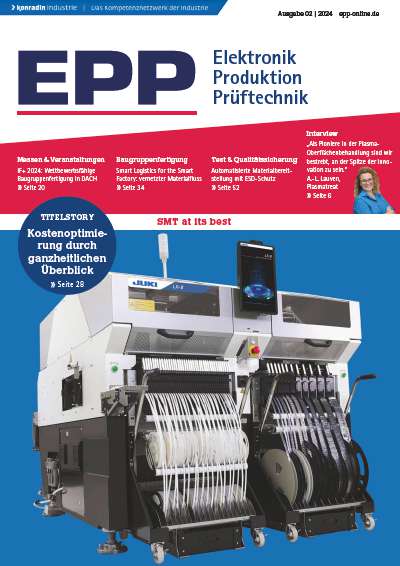DEK, headquartered in the South of England, has a famous position in the field of screen and stencil printing equipment. Today it operates under the multinational umbrella of the Dover Technologies Group alongside its sister firms Soltec and Universal. DEK’s general manager, Ian McEvoy, speaking to Gerhard B. Wolski, explains: „Our goals center around continuously innovating our products to further enhance the productivity of DEK’s customers.“
How do you position the company within Dover?
We are an autonomous subdivision of Dover Technologies and one of five business units within the Group. This means we are free to make our own market decisions and to pursue the technological directions and trends which we recognise as being the most significant. There has traditionally been a certain amount of internal debate whether Dover Technology should in some way centralize the activities of its subsidiaries or whether it should continue to allow them to operate independently. But we and our parent company share the philosophy that customers are best served if Dover companies maintain their independence. This is also according to Dover’s overall philosophy of keeping its overheads very low. There are less than 100 employees working within Dover Technologies at the Group level, and most of these are employed in the financial and legal areas. Therefore both DEK and our sister companies are left to cater to core functions such as engineering, research, manufacturing and sales.
Wouldn’t centralizing your activities create a valuable synergy among the companies?
The big question for us is whether DEK should view its core market as being specifically the printing sector or the entire SMT arena. SMT encompasses a formidably vast and complex range of board assembly processes, and is therefore a huge field. The print process is also widely considered to be the most critical step in the SMT process, because any problems there will be introduced at the very start of a board’s assembly, and can render the rest of the manufacturing process entirely useless. We decided to concentrate on printing because of its importance and the fact that it is our core competence. But at the same time we closely monitor developments in SMT that affect the printing technologies. The print sector itself also isn’t small and the market for our products is even wider than that defined by SMT or hybrid technology, as we can print onto almost everything, not just PCB substrates or wafers. For synergy, we allow this to flourish through very close working relationships with our virtual corporation partners and discussions with colleagues in our sister companies.
Is the use of advanced packaging starting to pick up now?
Yes it is, although it is still a slow, step-by-step process. The trend to avoid a critical lead pitch under 0.3-mil is driving leading edge packaging towards flip chip and BGA technology, as well as chip-scale packages (CSPs). CSPs are assembled by a print and placement process, so the biggest difference compared to traditional SMT remains within the component itself. One of the big advantages of these direct chip attach (DCA) methods, however, is that there is no interlayer between the wafer and substrate. This means manufacturers can put the bare die directly onto the board themselves and eliminate the lead time associated with the supply and availability of ICs. This also applies to flip chips and other packaging technologies that can be mastered by a board assembler itself, or a partner packaging service firm. We are nevertheless still only at the beginning of BGA and CSP technology, and the I/O pitches are still quite wide here. Over time these pitches will also come down to the 0.3-mil spacing of fine-pitch components today. Printing onto wafers for bumping of advanced packages is extremely critical because the pitches are very fine.
How is the current economic crisis in Asia affecting the equipment market?
There is a general lack of confidence throughout the market at the moment. Though Europe is relatively strong, there is very poor confidence in Asia which is now affecting America as well. Some companies are cancelling huge investments they were planning to make in manufacturing sites worldwide. It has long been Dover’s strategy, however, to invest heavily during such bad times as an effective way to break the cycle of such behaviour in our industry. We’re not facing this situation today but whenever we do, people in all areas of DEK’s business – from marketing and engineering to the shop floor – work hard on ways to improve or optimize our business.
Paste printing is the first step, do users expect more expertise from their machine vendor than any other?
The biggest issue driving the SMT process today is yield. If there is a problem with this, manufacturers will look towards the printer vendor, as they supply the first piece of equipment in the line on which almost everything is blamed. Though the printer has always been there, it’s viewed as much more important now. For a lot of users, it is the leading technology edge in printing that they look for us to provide. Thus, we are responsible for printing productivity. With a good printing process, the board quality and the yield are very high, defects are almost zero, and therefore rework and scrapping of boards is minimized. All this keeps costs down. So if our customers have a yield problem, we will be asked to go through all the potential printing-related defects, regardless of whether the problem does indeed technically stem from our printer or not.
Can you give an example?
After so many years it sometimes dismays me to discover that though a good print process depends on a relatively small number of basic rules, we still regularly find users who don’t know them. For example, the print process is much more prone to bridging if the aperture of the stencil and the pad is of the same size, but it works without problems if the aperture is smaller (about 80%) than the pad. We as a company know this; all our sales engineers know this; and all our support engineers know this. Yet it’s very surprising how many users aren’t aware of it. This is a printing issue, of course, but is not dependent on the printer or the paste. It is a stencil layout problem. Nonetheless, we are still obliged to resolve such problems as, in the eyes of the customer, the print machine vendor remains responsible for this part. So we don’t just sell machines. We also have to sell solutions to print-related problems.
I assume you offer training for your customers as well?
We do provide a lot of training, but I nevertheless believe that there is a lot of scope for making printing machines generally easier to understand and operate. A first step towards this is our revolutionary process alternative to the conventional squeegee: ProFlow DirEKt Imaging (the name given to the deposition technique) which we license to any equipment vendor. Though the concept was actually developed by the French firm Novatec, we took the initiative to implement this technology into screen printers. For the first time, total control over the paste and the printing process can be achieved at the print stage by direct imaging. When a machine is set-up properly and the board is flat, the process is very robust, provided the pad layout follows the usual rules.
Why is ProFlow an outstanding technique?
The main reason is the improved gasketing between the aperture and the pad. If this is done correctly, the process will show very good and precise results. Effective screen printing has for a long time been regarded as more of a black art than a science. But with the precision of direct imaging, this state of affairs is reversed. If the users set the right parameters, they will get a perfect print every time. Speed, gasketing and print pressure are completely under control. Paste wastage is minimized, the paste doesnÔt dry out, and it is ready to roll and go through the apertures. At the moment, we donÔt have special paste. We still use the same solder paste as that used by squeegees. We made ProFlow available on all our recent automatic machines for paste and adhesive printing.
After all the money DEK has spent developing ProFlow into a mainstream technology, it seems crazy to license it to competitors.
No, we are not crazy. The reason we are licensing this technique to everyone is because it is a major and fundamental breakthrough that will be very important for the next generation of printing processes. If a group of companies co-operate on this technique, then this will increase the total market size, and eventually allow manufacturers to print on other things besides SMT boards. A clean printing technology with many advantages opens up the market. There are many printing applications we don’t even address. I’m pleased to see that there is co-operation between us and our colleagues in other companies. There are enough other areas to make distinctions between our solutions and the competition because screen printing is more than just selling the machines. It is also understanding the complete process, talking to manufacturing people in their language, taking responsibility for their process-related issues, giving them the training, and offering support and service.
What about printing of adhesives?
On mixed-technology boards with SMDs and conventional components, it was often very difficult to print the glue with a stencil. Now we can print the dots easily in one stroke to attach the components for double-sided placement. With ProFlow it is even more easy to print the dots since the adhesive stays wet in the printer cassette and the process itself is clean. In addition, the costs have come down dramatically: it is not as expensive as using the latest high-speed, high-precision dispensing machines. Very few adhesives are made for printing. In most cases you take the normal dispensing material, but it works well.
What response did you receive from customers using ProFlow?
About 150 of our customers are using ProFlow. At the beginning, it took us a lot of time to convince some users to say farewell to the squeegee. But this is to be expected when any new technology arrives on the shop floor. People are looking for the advantages, of course, and the main point is the cost. Take for example paste wastage, which is typically in the region of 40% with conventional squeegees. Even though the ProFlow cassette can be slightly more costly, the drastically reduced wastage delivers cost savings very quickly. And all the other benefits of ProFlow come as standard with the machine. For example the faster print speed, improved yield, and greater cleanliness of the process. Wastage is relatively easy to quantify, and to express as a Dollar amount. That is something manufacturers can really identify with when looking for reduced production costs. Yield and cleanliness, on the other hand, are more difficult to correlate with dollars saved, especially where highly cost-sensitive customers are concerned. We work continuously to ensure ProFlow offers high performance and low cost, currently, to allow the user to get more paste out of each cassette, because a small amount remains trapped. This will produce even larger savings for them – though this is generally a minor detail as ProFlow is already far more cost-effective than traditional screen printing. A new cassette design will be introduced shortly which offers to users more paste from a cassette, while suppliers will find it far easier to fill.
Kein Frage, wenn es um Innovationen in der Printtechnik für die Elektronikfertigung geht, steht DEK weltweit an führender Stelle. Der Druckpionier hat mit der Adaptierung des ProFlow-Verfahrens frischen Wind in eine erstarrte Szene gebracht. Wie General-Manager Ian McEvoy erläutert, lizenziert man ProFlow selbst an Mitbewerber. Man will so dieser sauberen und kostengünstigeren Drucktechnik zum Durchbruch verhelfen.
Il ne fait aucun doute que DEK se situe à la pointe de l’innovation mondiale en ce qui concerne la technique des cartes imprimées pour la production électronique. En adaptant le procédé ProFlow, ce pionnier a fait souffler un vent nouveau sur un paysage figé. Comme le déclare son directeur général Ian McEvoy, les licences d’exploitation de ProFlow sont vendues même aux concurrents, ce qui ne manquera pas de faciliter la percée de cette technique d’impression propre et économique.
Nessun dubbio: se si tratta di innovazioni nella tecnica di stampaggio per la produzione di elementi elettronici la DEK è leader. Il pioniere dello stampaggio, con l’adattamento del processo Pro-Flow, ha portato aria fresca in un settore statico. Come affermato dal General Manager Ian McEvoy, si rilasciano licenze ProFlow anche ai concorrenti. In tale maniera si desidera portare al successo questa tecnica di stampaggio pulita ed economica.
DEK is headed by managing director John Knowles. Within the company’s structure, other rapidly growing subdivisions can be found: DEK Albany, lead by Peter Marshall, specializes in cleaning equipment, used and refurbished machines, and thick film screen printers. DEK Precision Screens (PSD) is lead by Martin Wyeth and manufactures screens and laser-cut stencils, having a strong foothold in U.K. and mainland Europe. DEK has manufacturing locations in both the U.K. and Japan. Its annual revenue exceeds $100m and the company employs over 500 people worldwide. Just-in-time and Kanban techniques have contributed significantly to reduced lead-times and highly efficient manufacturing. An entire business unit is also dedicated to advanced technology research. The company has a tight global support, sales and training network. Besides the British headquarters, there are four locations (with nine satellite offices) in the U.S., two in Japan (Tokyo and Osaka), three in Asia Pacific (Singapore, Taiwan, Shanghai), and three in continental Europe (Frankfurt, Paris, Oosterhout). The installed machine base numbers over one thousand printers worldwide. DEK is, of course, ISO 9000 qualified and has received CE and GS safety approval.
Unsere Webinar-Empfehlung
10.10.22 | 10:00 Uhr | Conformal Coating ist ein wichtiges Verfahren, um elektronische Baugruppen vor dem vorzeitigen Ausfall zu schützen. Damit bekommt der Beschichtungsprozess eine immer höhere Bedeutung. Dabei ist die Auftragsstärke ein wichtiges Qualitätskriterium. Nur eine…
Teilen:














